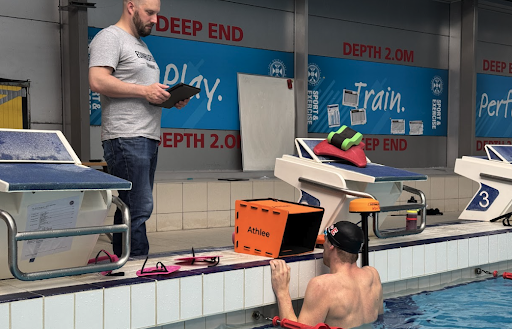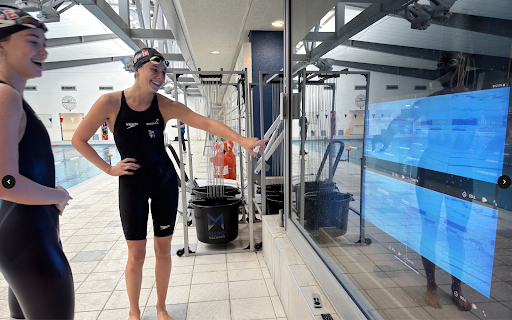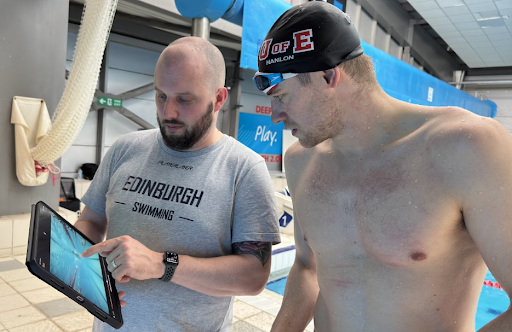Courtesy of Athlee, a SwimSwam partner.
Since we started using the cameras I have achieved loads of personal bests. The biggest being when I in Paris 2024 broke the World Record in 100 backstroke.” – Stephen Clegg, British Paralympic Gold Medalist 2024.
Recently, I spoke with Mathew Trodden, Head Swimming Coach – Elite Performance at Edinburgh University, and Stephen Clegg, who clinched two gold medals at the 2024 Paralympics in Paris. Together, they revealed how Trodden transformed his team’s training methods through day-to-day video feedback and how that contributed to Clegg’s record-breaking success.
Daily Video Feedback: A Game-Changer for Stephen Clegg
Stephen Clegg has been part of Mathew Trodden’s team at Edinburgh University for three years. His story stands out because of his impressive performance at the 2024 Paralympic Games in Paris and due to the significant factor he and Trodden credit for his recent successes: daily video feedback.
At first, it might seem surprising that a visually impaired swimmer could benefit from video feedback. Like many others, I wondered the same. But Clegg’s specific type of visual impairment allows him to use video feedback by either the contrast created with the Athlee Pool Box or on the 70-inch TV poolside, which has enabled more effective discussions with Trodden.
“Historically, Mat would ask me to change something, and I would think I had made the change,” Clegg explains, “but in reality, the change was so minor it wasn’t making any impact.” This scenario is a familiar challenge for many coaches: athletes often feel they are making significant adjustments to their movement patterns when, in reality, the changes are barely noticeable.
The introduction of Athlee cameras two years ago filled a critical gap in their communication, providing Clegg and Trodden with a precise tool for more effective exchanges and feedback. “Before we started using Athlee, I was relying completely on audible cues. It was a lot of guesswork, and many times I just couldn’t understand Mat’s vocal feedback. The cameras help me understand what Mat is seeing,” Stephen says. “The cameras are reducing the friction between me and Mat. It really helps clear things up for me.”
With live video feedback, Trodden has transformed the way he and his coaching team connect with their swimmers. His approach deepens the team’s understanding of technique and ensures stronger communication across all squads. Stephen Clegg, in particular, has felt the profound impact of this technology. “In the Paralympic field, I probably have the best underwater in the field now, and that’s hugely down to being able to understand what I am doing underwater through the use of the cameras on a day-to-day basis,” Stephen sums up.

Mathew Trodden, Head Swimming Coach – Elite Performance at the University of Edinburgh, and Stephen Clegg, Paralympic Gold Medalist. Photo via Athlee
Why Today’s Coaches Can’t Afford to Ignore Live Video Feedback
After speaking with Stephen, I sat with Trodden for his perspective as Head Swimming Coach at Edinburgh University. Trodden noted a major difference between the delayed video feedback he used before and the immediate feedback he now provides.
“In the past, with a GoPro, you might show the swimmers what you recorded 5 or 10 minutes later—best case scenario—or even the next session. By then, they lose the feeling of the water,” he says. Now, with real-time feedback, the effect is immediate. “It’s pretty incredible how much of a difference it makes. We can work on something straight away—‘How did that feel? What changed?’”
“Before, I’d film six or seven athletes, then spend hours uploading, adding voiceovers, and drawing lines,” Trodden recalls. It could take hours just to provide feedback for a single practice. The process was tedious, often leaving swimmers without immediate insights.
Now, Trodden has fully integrated video technology into daily training. Coaches at Edinburgh can film, annotate, and airdrop feedback to swimmers before they leave the pool. “Now, I spend time thinking about what I want to change and solve the problem. It’s incredible,” Trodden says.
The impact extends beyond coach-swimmer interaction. Through day-to-day video Mat has also transformed how the coaching team collaborates at Edinburgh University.

Mathew Trodden and team (some out of shot): Michael Mckenna (Exercise Physiologist), Matilda Mayne (Performance Psychologist), Danny Kirkham (Coach), Cameron Brodie (Performance Lifestyle) and Jacqueline Thow (Assistant Technician). Photo via Athlee
How Mat Has Transformed Team Collaboration at Edinburgh University
Mat has introduced regular Monday morning staff meetings. Every Monday morning, when Mat meets with his coaching team, “I play a video and have all the clever people in the room—whether it’s a technical issue, mobility, or strength—discuss and get a very clear image of what’s changed over time.”
With the continuous stream of videos from the previous week Mat and his team are now monitoring and guiding each swimmer’s development with data-driven insights rather than intuition. Changes are tracked, and their impacts are assessed over time. Not only does this develop swimmers, but it also drives the professional development of his staff:
“We are doing an awful lot of learning,” Trodden says. “Every day, we get to look at the whole picture and see when people are well or tired. How does that change? Does it affect their stroke technique? How much does it change their distance per stroke, even in training?”
This approach lets Trodden focus on what drives him most as a coach: his passion for swimming and a desire to deeply understand movement in the water. “I really want to understand movement better. That’s the key thing,” he says. This curiosity is common among top coaches. David Marsh, for example, shared a similar focus in a recent interview.
Motivating an Increasing Number of Visual Learners
After analyzing what needs to change, Trodden asks an equally important question: “How do we transfer what we have on the land into the pool?” Stephen Clegg‘s story highlights how Trodden and his team work closely with swimmers to translate insights into concrete biomechanical changes.
And the swimmers are now actively requesting video feedback from Trodden as part of their training. “If we warm up and the cameras aren’t on, I’ll hear, ‘Are we getting the cameras in today?’” Trodden notes. “It’s something that they obviously value.”
To Trodden, it’s clear that more of today’s swimmers are becoming visual learners, “because that’s the input we all get the most off on a daily basis,” he observes. But this interest goes beyond surface-level curiosity. Beneath the enthusiasm is a deeper motivation: the desire to see tangible progress. “They work so long and so hard, especially the senior swimmers, and they don’t always see development. Now we can show technical development very easily, and I think that’s important,” Trodden explains. “It’s made the swimmers more aware of their swimming, and I experience more engaged athletes.”
Clegg puts it like this:
“Mat’s new focus on video feedback has changed my relationship with swimming. For me, swimming was becoming quite boring and frustrating because it was very much just battering up and down the pool as hard as I could. Now it’s a lot more technical and more engaging and just all-around fun because learning how to swim fast is very fun.”

Drew McKenzie and Ciara Schlosshan, Elite Performance team at the University of Edinburgh. Photo via Athlee
A Benefit of Peer Learning that Has Surprised Trodden
With cameras and iPads on the pool deck, Trodden has noticed a shift in how swimmers interact. “Swimmers can see themselves and compare with others, learning by observing what their teammates do well.” This peer observation has become a valuable part of their development.
Trodden shares that video feedback has pushed swimmers to coach each other. “Swimmers can almost act as coaches for each other,” he says. With live feedback and an adjustable delay, they review performances, challenge one another, and ask critical questions.
“It’s great watching them help each other,” Trodden adds. “They’re not just focused on their own performance—they’re learning from their teammates’ strengths and improvements.” This peer learning has brought an unexpected benefit for Trodden—he finds himself learning from his swimmers.
“Unfortunately, I’m never going to get closer to them; I’m only getting older, but they’re going to stay the same age,” he reflects. By listening in on their feedback sessions, he has picked up new words and perspectives. “I’m actually learning a lot from how they describe things. I listen to their conversations, and it helps me adjust my communication to better relate to them,” he says.
But the most significant impact is on the swimmers themselves. For Trodden, this might be the most important outcome, as he puts it:
“My biggest philosophy is just to make sure my swimmers enjoy swimming,” he says.
Note: Mathew Trodens’ participation in this interview is entirely independent, and he is not compensated by or affiliated with Athlee.
